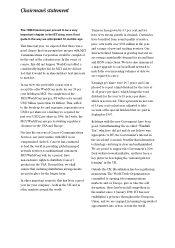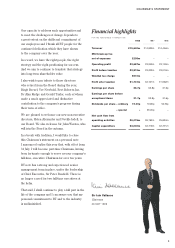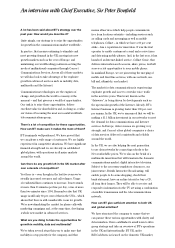BT 1998 Annual Report Download - page 10
Download and view the complete annual report
Please find page 10 of the 1998 BT annual report below. You can navigate through the pages in the report by either clicking on the pages listed below, or by using the keyword search tool below to find specific information within the annual report.
U S I N E S S RE V I E W
Multimedia is already growing fast, with 10 million e-mails
sent each day in the UK and 30 new web pages set up on
the Internet every minute. Around five per cent of local
call traffic carried by BT is now Internet-related.
Multimedia’s popularity is set to increase rapidly. BT trials
show that 60 per cent of people would prefer their
television service to feature interactivity and the ability to
call up videos on demand.
The network
Multimedia’s uptake will depend on the capacity of
networks to deliver its material and to provide return
channels through which consumers can respond to what
is broadcast or distributed. BT is therefore working to
provide the best possible networks, while keeping costs
within affordable limits.
During the year, we announced that we would spend an
additional £300 million on upgrading our network to
enable it to carr y more data at faster speeds. Such an
upgrade will help the network support new services such
as Home Highway. Home Highway is a new digital
communications service that will transform a customer’s
existing home telephone line into a high-speed Internet
and multimedia connection.
Much of our cur rent network investment is focused on
the ways that technology can make our existing network
investment carry all the latest services by – for example –
delivering video services over the existing copper
network. This will enable us to provide new services
at the most affordable price.
BT is carrying out trials of ADSL (asymmetric digital
subscriber loop) technology, which uses compression
techniques to increase the capacity of a phone line 30-fold,
giving high-speed Internet access, TV-quality video and
CD-quality audio.
Variants on this theme are also in development, including
the highly economical DSL Lite and the more expensive
VDSL (very high-speed digital subscriber loop).
In March 1998, it was announced that BT will be working
with Microsoft subsidiary WebTV Networks in a trial of
the WebTV service, for which BT will be the Internet
service provider.
Mobility solutions
BT is also enhancing and sharpening its focus on the
mobile telecommunications market, expanding the way
it has traditionally thought of customers’ mobility
requirements.
Analysts predict that, within five years, the mobile
communications market will account for 30 per cent of all
telecommunications revenues, with some 12 to 14 million
people in the UK having a mobile phone, compared with
nine million today.
Cellnet
BT has a 60 per cent stake in Cellnet, the mobile
telecommunications network operator, and – through
BT Mobile – offers customers a range of integrated
and innovative mobility solutions, enabling them to
stay in touch wherever they are.
Cellnet has more than three million customers, the vast
majority of whom are connected to the digital GSM
network.
Number of Cellnet’s digital
connections (thousands)
94 95 96 97 98
Cellnet was the first UK network to offer a full, two-way
digital fax and data service. In effect, a fax number is
assigned to an individual rather than a machine. Mobile
phone users can now receive and send data securely while
on the move in many of the countries with which Cellnet
has “roaming” agreements.
September 1997 saw the launch of Cellnet Genie, a world
first and one of the UK’s most comprehensive free
information sources on the Internet. The Genie website
brings together the very latest information on news and
current affairs, sport, finance, entertainment, travel and
careers on one web site. Customers accessing the site can
ask for information to be delivered to their mobile phone
via text messages or to an e-mail address.























